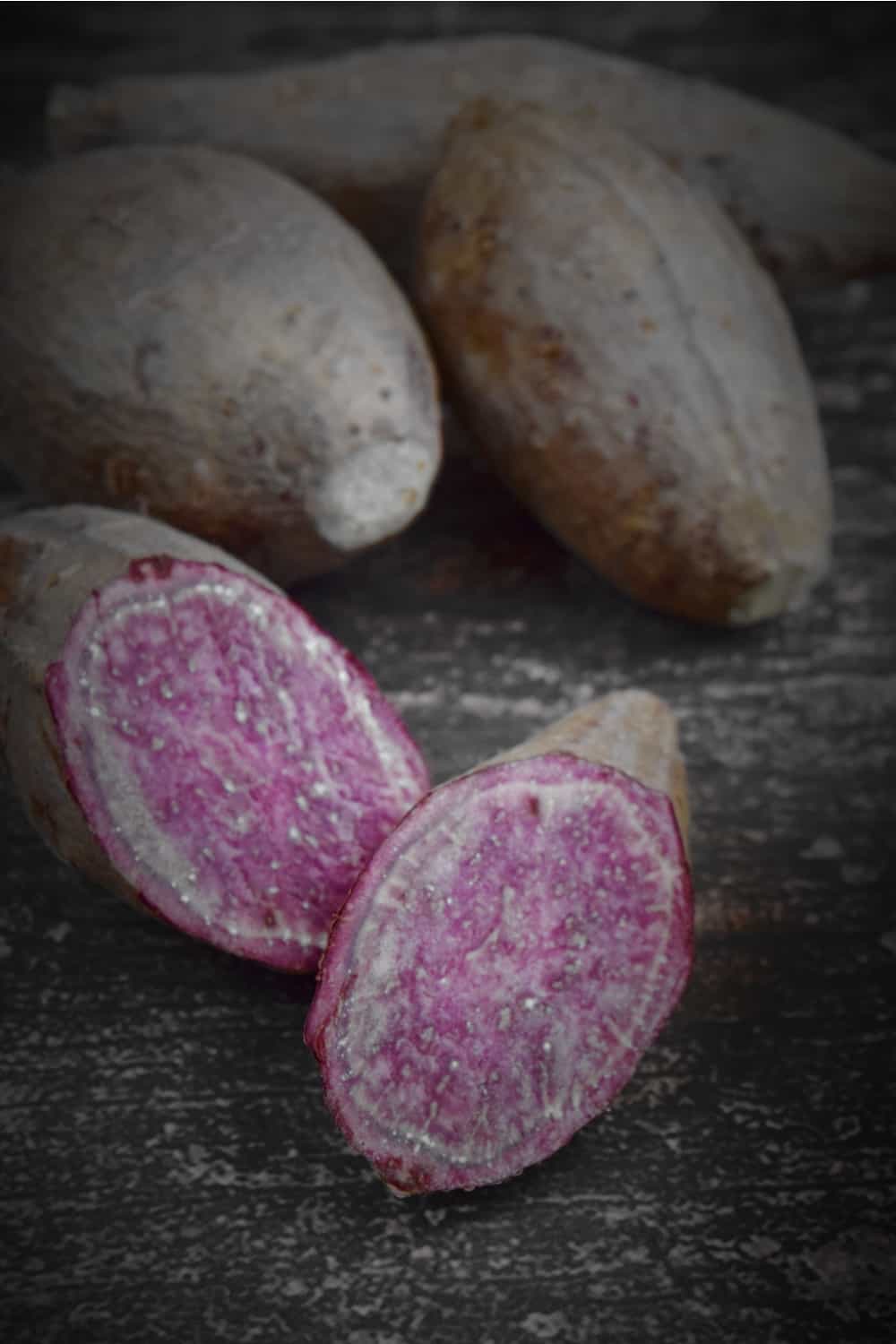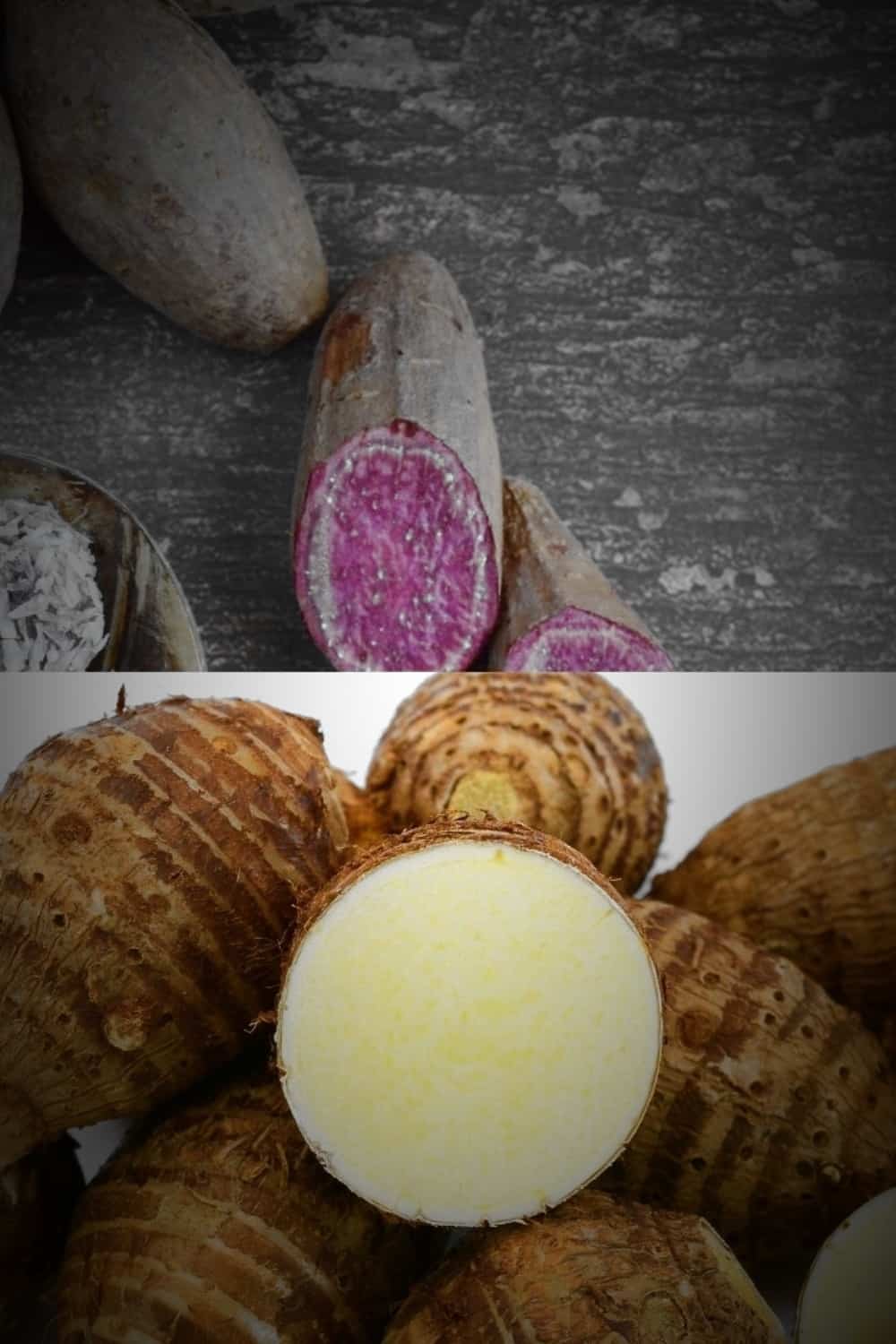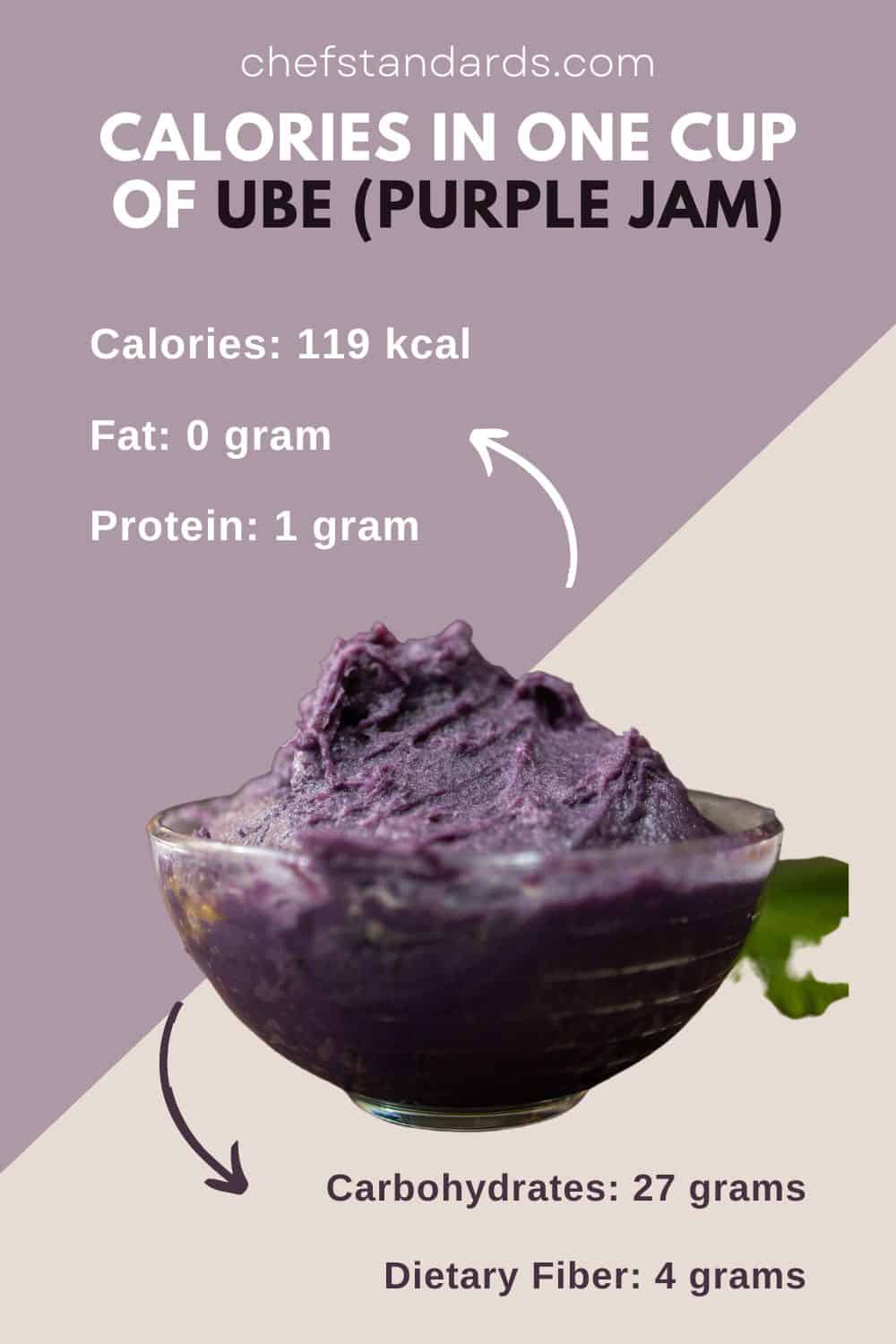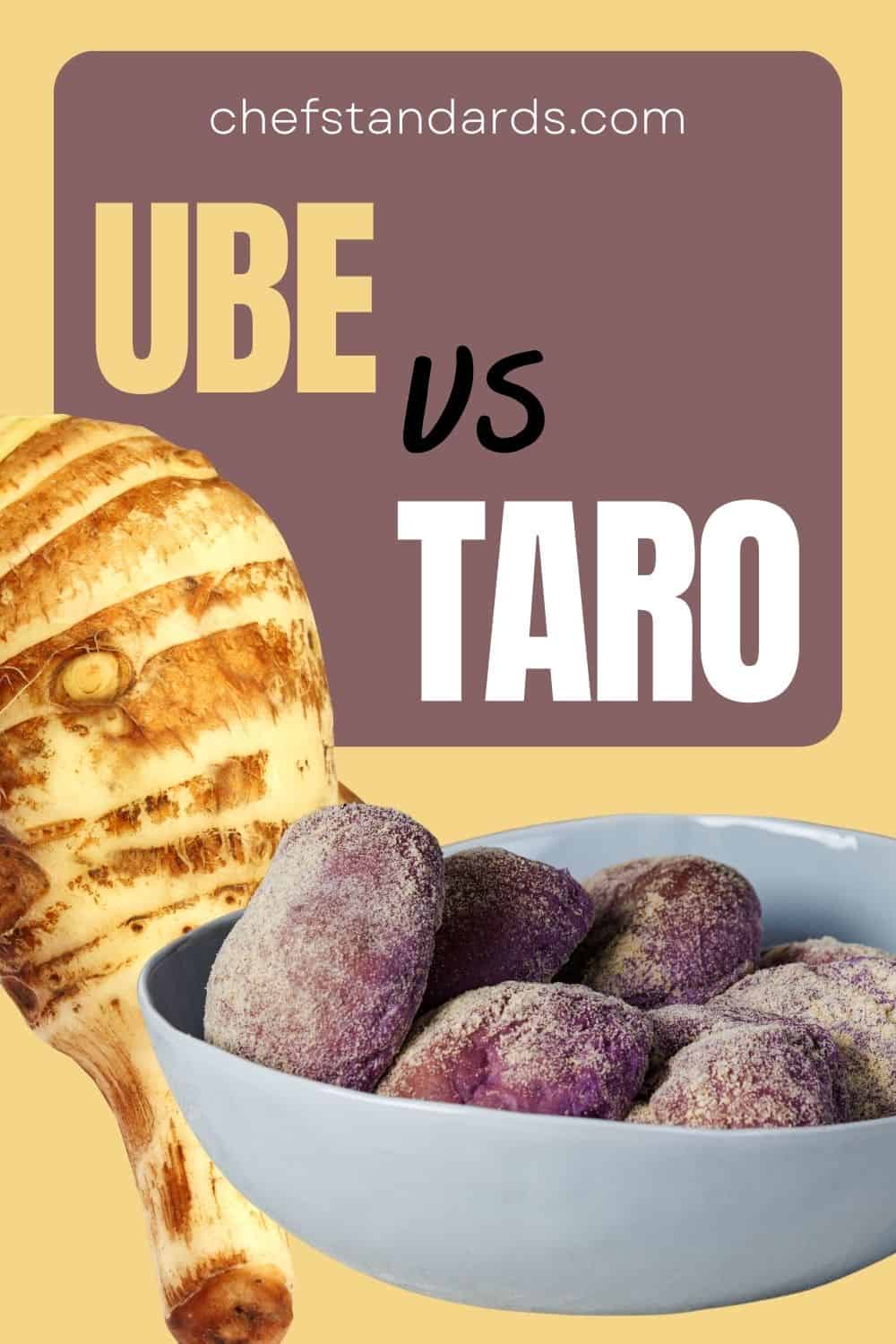If you don’t live in the Philippines or some part of Southeast Asia, you most likely need to learn more about ube and taro.
Many people here in the West still think that these two types of vegetables are the same. And, although they are quite similar, especially in powdered form, they are not the same and have some major differences.
Exactly because of that, I wrote this article to explain the differences between ube vs taro.
So, if you are interested and want to know more about their differences, as well as some other important facts related to ube and taro, I suggest that you continue reading.
Ube Vs Taro: Facts About These Root Vegetables
Before I head to the main part, I will say a few words about both types of these amazing vegetables and reveal some important facts that will help you to differentiate between them more easily. Let’s start with ube.
About Ube

Ube is just one of the common names for this vegetable. It is also known as purple yam and greater yam. Its scientific name is Dioscorea alata.
This specific vegetable belongs to the species of yam or tuber that are usually a vivid violet-purple to bright lavender in color. It is this vivid purple color that makes ube recognizable.
The family in which ube finds its place is the so-called Dioscoreaceae family, also known as the sweet potato family.
It is a root vegetable that originated in Southeast Asia, but can mostly be found in the Philippines. There, it is a well-known ingredient in various dishes, especially in snacks and desserts like purple ice cream, ube boba, and ube-filled bread.
Aside from being confused with taro, ube is also confused with Okinawan sweet potato because they both belong to the same family and because ube is also grown in Okinawa.
About Taro

Just like ube, taro is also a type of root vegetable. More precisely, taro is a root crop, a part of the bigger taro plant (Colocasia Esculenta) that contains corms, leaves, and petioles.
Taro is also known by the name Dasheen, a name that comes from the Maori language of New Zealand. The reason behind this is the fact that it was first discovered by the natives of New Zealand.
Although it originated in New Zealand, it can mostly be found in parts of Southeast Asia, as well as India.
People often confuse it with ube because both types of vegetables have bark-like skin. However, they actually do not belong to the same family since taro belongs to the so-called Araceae family.
6 Main Differences Between Taro And Ube
Finally, here is the main part of today’s article about two very similar root vegetables, i.e. differences between ube vs taro. Now that you know the general information about both of them, you will be able to understand their differences more easily.
1. Appearance

You were previously able to find out that both types of vegetables have a bark-like skin, but what differentiates these two in terms of appearance?
I will start with the outside appearance. Namely, ube has skin that is bright-purple in color and somewhat smooth. And that is actually its trademark and something that you can notice immediately.
Taro, on the other hand, looks more like a potato, although, unlike ube, it doesn’t belong to the same family as sweet potatoes. It is round in shape, has brown-colored skin, and is somewhat rough. However, unlike potato skin, the skin of taro is considered unedible.
Those are the outside differences between ube vs taro. Once you cut them in half, you will also find some differences in their inner flesh.
Just like the noticeable purple color of the skin, the flesh of the ube is also purple in color.
When it comes to the color of taros’ flesh, it is mostly white, but it has little purple dots when freshly cut.
Once you cook it, its color will transform into light purple, the color that you can easily notice in your taro boba milk tea.
2. Flavor
Just like in the previous section, here I will start with the ube as well. As you have already learned, ube is one of the most popular ingredients used in Filipino dessert recipes.
That leads us to the conclusion that an ube has a sweet taste. Although that is not characteristic of the root vegetable, ube really has a sweet taste that is similar to those of chocolate, pistachio, and vanilla.
Most types of ube have a gentle sweet flavor, i.e. a flavor that is not very intense. However, it is important to emphasize that the exact level of sweetness depends on the size of the ube, as well as the way it was grown.
The bigger the ube, the sweeter it is. Also, if it has been wintered the right way, the starch breaks down more easily resulting in a sweeter flavor, something similar to vanilla flavor which is awesome.
When it comes to taro flavor profile, it is somewhat opposite to the flavor profile of ube. I am saying this because taro has a predominantly earthy and nutty flavor. Because of that, it is mostly used as an ingredient in savory dishes.
However, it is also important to emphasize that it possesses some sweet undertones, which makes it suitable for some sweet dishes and desserts where the sweetness is not so dominant.
Also, it tastes somewhat similar to tapioca pearls, the same ones used in boba or bubble tea.
One more note. Since many people consume taro in powdered form, they are often confused by its high level of sweetness.
However, you should know that it is the direct consequence of powder producers adding sweeteners.
3. Texture
When you speak about the texture of ube, you must mention the potato. The textures of these two root vegetables are quite similar. Namely, just like a potato, raw ube has a firm and dense texture.
It is also important to emphasize that it has a slightly sticky outer layer, which makes it difficult to peel. However, once you succeed in that and cut it open, you will find somewhat creamy and starchy flesh inside.
Once it is cooked, the ube becomes much smoother and creamier.
When it comes to raw taro, it also has fibrous skin that is somewhat tougher than that of ube. The flesh is also starchy, but it possesses a slightly grainy texture.
However, once you cook it, the texture becomes much creamier, but when eaten, it still keeps a chalky, grainy taste to some extent.
4. Calories
There aren’t significant differences in the number of calories between these two root vegetables. But nonetheless, if there are even slight ones, it is important to know them. So, I will start with the number of calories in one cup of ube root.

Calories In One Cup Of Taro Root (Dasheen):
• Calories: 187 kcal
• Fat: 0.1 grams
• Protein: 1 gram
• Carbohydrates: 39 grams
• Fiber: 7 grams
• Sugar: 1 gram
5. Nutrition And Health Benefits
Both of these root vegetables are low-caloric ingredients and below you will see that both have rich nutrition values and consequently can provide numerous health benefits. Just like in previous sections, here I will also start with ube or purple yam.
Ube is a very nutritious vegetable and it is a great source of these important nutrients:
• Complex Carbs
• Potassium
• Vitamin C
• Antioxidants anthocyanins
Ube is probably best known as one of the top sources of antioxidants known as anthocyanins, which are good in reducing inflammation, and consequently many inflammatory diseases like certain cancers and type 2 diabetes.
Aside from anthocyanin, ube also contains a high amount of vitamin C and we all know that this vitamin is essential for many processes in our body.
Finally, it is a great source of complex carbs, also known as good carbs. These carbs transfer into glucose very slowly, not resulting in spikes of blood sugar and giving you the energy you need at the same time.
Taro is quite similar when it comes to nutrition. It is also low in calories, high in complex carbs, and high in certain nutrients that are essential for our health. Below, I will list the 3 most important nutrients in taro root.
• Vitamin C
• Vitamin B6
• Vitamin E
Like ube, taro is also a good source of one of the most important vitamins of all, vitamin C, which provides numerous health benefits.
However, taro also contains a high amount of vitamin B6. And this vitamin is very beneficial for our brain and especially the nervous system. It is also good for the immune system.
Finally, vitamin E is good for maintaining healthy eyes and skin, as well as protecting you from various illnesses and infections.
I also have to emphasize that both taro and ube contain complex carbs mixed with lots of fiber that doesn’t spike sugar and insulin levels and give you the needed energy throughout the day.
6. Culinary Uses
When it comes to purple yam, you already know that it has a sweeter taste than taro, and that makes it suitable for various types of desserts. You can incorporate it into cakes, pastries, as well as ice cream.
Exactly that ube ice cream is used for making the most popular Filipino dessert known as halo-halo.
Aside from dessert, some people even use it for making baked dishes as it provides their muffins or bread with that specific purple hue.
It can be incorporated into smoothies and this is personally my favorite way to use this incredible ingredient.
Ube is also used for making jams and spreads and some even use it in powder form to spread it over donuts and donut holes.
Taro is a little bit different in terms of culinary uses since it is less sweet and has more savory flavors.
It is therefore more suitable for savory dishes. It is mostly used in soups and stews to add some extra nutty flavor. Aside from that, taro can be used as a side dish instead of potatoes.
It can also be sliced, fried, and served as a snack, a healthier alternative to regular potato chips.
Some people even boil it and make sauces and pastes from it.
Finally, although it is not so sweet, it can be also used for making desserts, like for example popular taro root cake. Those desserts will be the perfect combination of sweet and nutty flavors and some people find that flavor profile very pleasant.
Also, if you want to make a delicious drink with taro powder, make yourself taro milk tea and you will experience the perfect combination of sweet, nutty, vanilla, and tea flavors.
You can also make an egg pudding boba variation with a taro flavor.
FAQs

Why Is Taro Purple?
Fresh taro vegetables aren’t purple in color. Only some types of powdered taro may have a slight purple color.
That is because some manufacturers add food coloring to the powder while processing it.
Is Taro The Same As Purple Sweet Potato?
No, taro and purple sweet potato are two different root vegetables. Purple sweet potato is a type of sweet potato that contains antioxidants known as anthocyanin which gives it that specific purple color.
It is sweet in flavor and it has a creamy and smooth texture that is more similar to that of purple yam.
Taro, on the other hand, is also a root vegetable that has a similar appearance, but it is not a type of sweet potato and it has a savory flavor with some slightly sweet undertones.
Ube Vs Taro Summary
In this final summary section of ube vs taro comparison, I will briefly go through the main differences between these two amazing root vegetables in each of the 6 key differences.
• Appearance: Ube has bright-purple skin that is somewhat smooth, while taro skin is brown in color and slightly rough.
• Flavor: Purple yam has a predominantly sweet flavor, while the flavor profile of taro is a combination of nutty and earthy flavors with slightly sweet undertones.
• Texture: Ube has a firm and dense texture with a sticky outer layer, while taro has fibrous skin that is somewhat tougher.
• Calories: Both are low-caloric root vegetables, but taro contains a bit more calories than purple yam.
• Nutrition And Health Benefits: Ube is loaded with vitamin C, potassium, anthocyanin, and complex carbs, while taro is rich in vitamins B6 and E, as well as vitamin C.
• Culinary Uses: Purple yam is sweeter than taro and therefore more suitable for desserts, while earthy and nutty taro is mostly used in savory dishes.


